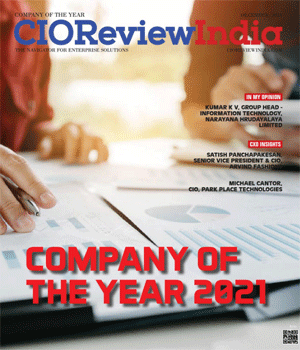
RPA - The Present and the Future
Jacob Peter, Vice President BU Head-(IT Business Solutions), Robert Bosch Engineering and Business Solutions | Friday, 06 October 2017, 07:36 IST
 Off late, Automation has become one of the most talked about topic in the IT business fraternity. There is a combination of excitement and concern on how this would disrupt the status quo. This topic has been of interest to the industry from the time of its early evolution. Exponential growth of connectivity between humans and things, brings in the advent of Industry 4.0 which is the next wave of industrialization and with it, new techniques in automation.
Off late, Automation has become one of the most talked about topic in the IT business fraternity. There is a combination of excitement and concern on how this would disrupt the status quo. This topic has been of interest to the industry from the time of its early evolution. Exponential growth of connectivity between humans and things, brings in the advent of Industry 4.0 which is the next wave of industrialization and with it, new techniques in automation.
The Past
The advent of computers accelerated automation. Automation of functionality was at the core–Software (SW) dictates the functionality of products and business processes. Millions of lines of codes make up the intelligence behind the products of our daily use – be it a mobile phone, automobile or washing machine. Enterprises rely on packaged SW being configured or custom applications developed to run their businesses. This meant that we needed an army of programmers to develop, test, and maintain this code. We had engineers developing SW to handle the complex business environment and back office personnel taking care of operations.
The Present
We are now at the dawn of fourth Industrial revolution where autonomous and Cyber-physical systems would become pervasive and integrated in all walks of daily life. Customer centric design would form the core – which means functionality like mobility on demand, with a high reliability and quick time to market will be an implicit expectation. The way we conceptualize software, build software, test it and deploy is getting transformed. Many newer concepts like Machine Learning, Artificial Intelligence (AI) are entering into every part of the Software.
The current focus of Automation centers around Robotic Process Automation (RPA) aiding Business Process Automation, IT Process Automation (ITPA) aiding IT Infra automation while Machine learning is mostly used in voice and customer interface process through technologies like Natural Language Processing (NLP).
From our experience of implementing RPA/ ITPA, rather than focusing on the immediate benefits of automation (productivity), we should look at it holistically. We have observed the following key benefits during the implementation of automation,
1. Process Definition: It allowed us to look at the process more closely and define workflows in a way that allowed optimum use of automation. Automation also brings out the process bottlenecks.
2. Insights & Analytics: Data analytics enables constant improvement of process.
3. Risk management: Automation frees the processes from human error and has the ability for instant ramp up and down which helps in better management of uncertainties and brings down risks to a more accepted level.
4. Better customer experience: Automation with cognitive and artificial intelligence provides organizations with better tools to analyze market insights and offer better products. Increased service quality with 100% accuracy rate due to high repeatability and zero fatigue, decreasing delivery time results in better customer experience.
5. Cost Savings: The reduced process time, lower error rate and process transformation results in cost savings. When one looks at the cost savings from automation, benefits accrued from the above 4 points should also be considered. If only replacement of workforce is considered, the benefits may be limited considering the license cost and support required to maintain it.
Some of the key aspects that has to being focus while embarking on implementing automation are:
1. Analyzing the benefits of bringing in Automation/ Digital work force: This brings focus on the Why question. Why are we embarking on this initiative? Is it for Cost benefits? Is it for easier 24X7 operations? This would also determine the automation tool and technique that would be used.
2. Defining the Digital workforce concept: This phase includes setting up a robust governance framework which enables SW Robots to work alongside normal workforce.
3. Identifying the candidate process: This phase involves piloting and getting the first few that would determine the rollout approach.
4. Rollout process: This phase would be the org-wide rollout across the identified process. At this juncture the workforce planning should also be revisited.
Future Prospects:
We view automation as an enabler which will free up individuals from the mundane part of their work and will give them freedom to innovate and perform better. It would also mean some re-skilling. Learning/training/ adapting becomes a continuous endeavor in automation.
Though Automation might cause a contraction in labor markets in near term in traditional software/business segments, newer areaslike Big Data Analysts, BOT development, Supervised and unsupervised training of bots, cybersecurity would open up which create demand for newer skills.
Model-based development is already used widely in automating the SW development phase (mainly in engineering). As automation moves ahead, entering into the world of Artificial intelligence, organizations will find new ways to use cognitive tools to make their job easier. AI aided automation would come aid in the build phase of SW development in a major way. Learning systems would be at the heart of SW from autonomous driving to expert systems aiding medical diagnosis.
In the coming years, the companies that will grow & dominate their industries will be those that systematically embrace automation and AI across their organizations.
Disclaimer: All trademarks are acknowledged.
CIO Viewpoint
How Can MSME Digitally Grow Business During...
By Srivaths Varadharajan
It's Time We Breakdown Our Data Security Fallacies
By Priyank Kothari, Head - Information Security, Tesco
The Right Side Of Digital Transformation
By Upinder Phanda, Vice President and CIO, Unisys Corporation
CXO Insights
By DR. Makarand Sawant, Senior General Manager IT, Deepak Fertilizers and Petrochemicals Corporation Limited
The State Of Customized Lending
By Sean Hunter, Chief Information Officer at OakNorth
10 Common Types Of Malware And How To Combat...












